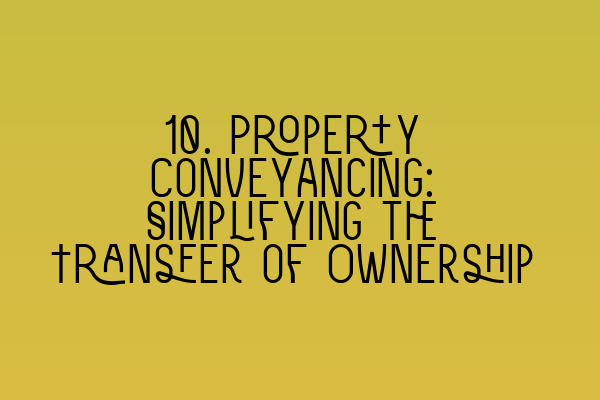10. Property Conveyancing: Simplifying the Transfer of Ownership
When it comes to buying or selling a property, the process can often seem overwhelming and confusing. That’s where property conveyancing comes in. Property conveyancing is the legal process of transferring ownership of a property from one party to another. Whether you’re a buyer or a seller, understanding this process is essential to ensure a smooth transaction.
At SQE Property Law & Land Law, we specialize in helping clients navigate the intricacies of property conveyancing. Our team of experienced solicitors is dedicated to simplifying the transfer of ownership, providing professional and reliable guidance every step of the way.
In this article, we’ll break down the property conveyancing process into easy-to-understand steps, eliminating any confusion and shedding light on its importance. So, grab a cup of coffee, sit back, and let’s dive in!
1. The Initial Stage: Instruction and Documentation
The conveyancing process begins with the buyer instructing a solicitor or conveyancer. The solicitor will then draft a formal instruction letter, requesting necessary documents such as the draft contract, property information form, and fixtures, fittings, and contents form.
During this stage, it’s crucial to gather all relevant information about the property, including its title deeds, planning permissions, and any potential restrictions or liabilities that may impact the purchase.
2. Pre-Contract Enquiries and Searches
Once the necessary documentation is obtained, the buyer’s solicitor will conduct various searches and raise pre-contract enquiries. These searches typically include local authority searches, environmental searches, drainage and water searches, and chancel repair liability searches.
These searches aim to uncover any issues or potential risks associated with the property, ensuring that the buyer is fully informed before proceeding with the purchase.
3. Reviewing and Negotiating the Contract
After the searches and enquiries are complete, the buyer’s solicitor will carefully review the draft contract and highlight any areas of concern. They will negotiate with the seller’s solicitor to ensure that the contract is fair and compliant with the buyer’s requirements.
At this stage, it’s crucial to seek legal advice to protect your interests and understand the contract’s terms and conditions fully.
4. Mortgage Arrangements
If the buyer is purchasing the property with the help of a mortgage, they will need to arrange for a mortgage offer from a lender. The buyer’s solicitor will liaise with the lender to ensure that all necessary documentation is provided and that the mortgage offer aligns with the agreed terms of the purchase.
5. Exchange of Contracts
Once all negotiations have been finalized, both parties will sign and exchange contracts. At this point, the transaction becomes legally binding, and both the buyer and seller are committed to completing the sale/purchase.
A deposit is usually paid at this stage, typically 10% of the property’s purchase price. The completion date is agreed upon between both parties and is usually set for a few weeks after the exchange of contracts.
6. Completion and Post-Completion
On the agreed completion date, the buyer’s solicitor will transfer the remaining funds to the seller’s solicitor, and the keys to the property will be released to the buyer. This marks the completion of the transaction.
However, the conveyancing process doesn’t end here. The buyer’s solicitor will still need to register the change of ownership with the Land Registry, finalize any outstanding payments, and handle the payment of Stamp Duty Land Tax (SDLT), if applicable.
7. After Completion
After completion, it’s essential to update utility providers, insurance companies, and relevant authorities with the change of ownership details. This ensures a smooth transition and avoids any potential disputes or issues relating to services or insurance coverage.
At SQE Property Law & Land Law, we understand the complexity of the property conveyancing process and strive to simplify it for our clients. Our skilled team of solicitors will guide you through each stage, offering professional advice and expertise to ensure a seamless transfer of ownership.
For more information about the SQE exams and preparation, check out our related articles:
– [SQE 1 Practice Exam Questions](https://fqps.co.uk/sqe/sqe1-preparation/mcq-practice-quiz)
– [SQE 1 Practice Mocks FLK1 FLK2](https://fqps.co.uk/sqe/sqe1-preparation/practice-mocks-quiz)
– [SQE 2 Preparation Courses](https://fqps.co.uk/sqe/sqe2-preparation)
– [SQE 1 Preparation Courses](https://fqps.co.uk/sqe/sqe1-preparation)
– [SRA SQE Exam Dates](https://fqps.co.uk/sqe/sqe1-sqe2-exam-dates)
In conclusion, property conveyancing is a vital process in the transfer of property ownership. With the assistance of a knowledgeable solicitor, you can simplify this complex process, ensuring a smooth and successful transaction. If you’re looking for expert advice and guidance in property conveyancing, contact SQE Property Law & Land Law today.
